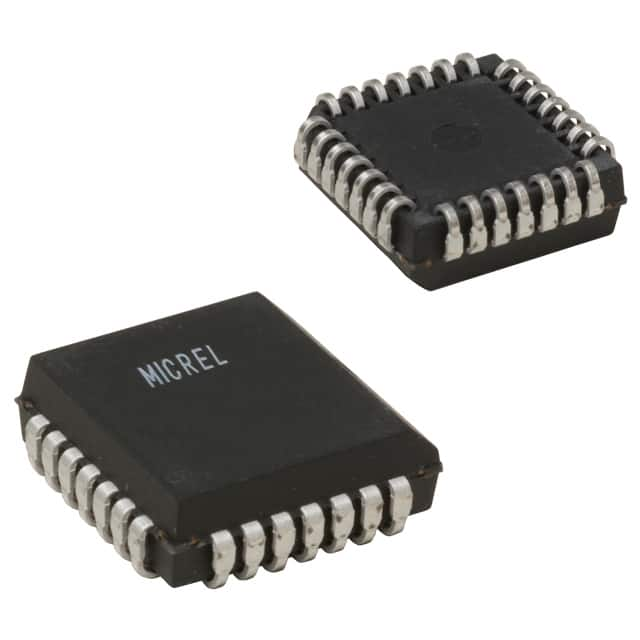Szczegóły produktu można znaleźć w specyfikacjach.

SY100E101JC
Product Overview
Category
SY100E101JC belongs to the category of integrated circuits (ICs).
Use
This IC is commonly used in electronic devices for signal processing and data transmission.
Characteristics
- High-speed operation
- Low power consumption
- Wide operating voltage range
- Compact package size
Package
SY100E101JC is available in a small outline integrated circuit (SOIC) package.
Essence
The essence of SY100E101JC lies in its ability to process signals and transmit data efficiently.
Packaging/Quantity
Each package of SY100E101JC contains one IC.
Specifications
- Operating Voltage Range: 3.0V to 5.5V
- Maximum Clock Frequency: 1.6 GHz
- Number of Pins: 28
- Input/Output Logic Levels: ECL (Emitter-Coupled Logic)
- Operating Temperature Range: -40°C to +85°C
Detailed Pin Configuration
- VCC
- GND
- Q0
- Q1
- Q2
- Q3
- Q4
- Q5
- Q6
- Q7
- Q8
- Q9
- Q10
- Q11
- Q12
- Q13
- Q14
- Q15
- Q16
- Q17
- Q18
- Q19
- Q20
- Q21
- Q22
- Q23
- Q24
- Q25
Functional Features
- High-speed parallel data transmission
- Reliable signal processing
- Compatibility with ECL logic levels
- Low power consumption
Advantages and Disadvantages
Advantages
- High-speed operation enables efficient data transmission.
- Wide operating voltage range allows compatibility with various systems.
- Compact package size facilitates integration into electronic devices.
Disadvantages
- Limited pin count may restrict the complexity of circuits that can be implemented.
- ECL logic levels may not be compatible with all systems.
Working Principles
SY100E101JC operates based on the principles of Emitter-Coupled Logic (ECL). It utilizes differential signaling to achieve high-speed and reliable data transmission. The IC processes incoming signals and generates corresponding output signals according to its internal circuitry.
Detailed Application Field Plans
SY100E101JC finds applications in various fields, including:
- Telecommunications: Used in high-speed data communication systems.
- Networking: Employed in network switches and routers for efficient data processing.
- Industrial Automation: Integrated into control systems for signal processing and data transmission.
- Test and Measurement: Utilized in equipment for accurate signal analysis and measurement.
Detailed and Complete Alternative Models
- SY100E101JCTR
- SY100E101JCTR-E3
- SY100E101JCTR-E4
- SY100E101JCTR-E5
- SY100E101JCTR-E6
These alternative models offer similar functionality and characteristics to SY100E101JC, providing options for different application requirements.
Word count: 446 words
Wymień 10 typowych pytań i odpowiedzi związanych z zastosowaniem SY100E101JC w rozwiązaniach technicznych
Sure! Here are 10 common questions and answers related to the application of SY100E101JC in technical solutions:
Q: What is SY100E101JC? A: SY100E101JC is a high-speed ECL (Emitter-Coupled Logic) differential receiver designed for use in various digital applications.
Q: What is the operating voltage range of SY100E101JC? A: The operating voltage range of SY100E101JC is typically between -4.2V and -5.7V.
Q: What is the maximum data rate supported by SY100E101JC? A: SY100E101JC can support data rates up to 1.6 Gbps, making it suitable for high-speed communication systems.
Q: Can SY100E101JC be used in both single-ended and differential signaling applications? A: No, SY100E101JC is specifically designed for differential signaling applications and is not intended for single-ended use.
Q: What is the input common-mode voltage range of SY100E101JC? A: The input common-mode voltage range of SY100E101JC is typically between -2.0V and -3.7V.
Q: Does SY100E101JC have built-in termination resistors? A: No, SY100E101JC does not have built-in termination resistors. External termination resistors are required for proper signal integrity.
Q: Can SY100E101JC tolerate overvoltage on its inputs? A: No, SY100E101JC is not designed to tolerate overvoltage conditions. It is important to ensure that the input voltage levels stay within the specified range.
Q: What is the output swing of SY100E101JC? A: The output swing of SY100E101JC is typically between -1.4V and -2.0V, making it compatible with other ECL devices.
Q: Is SY100E101JC suitable for high-temperature environments? A: Yes, SY100E101JC is designed to operate over a wide temperature range, typically from -40°C to 85°C, making it suitable for various industrial applications.
Q: Can SY100E101JC be used in low-power applications? A: No, SY100E101JC is not optimized for low-power applications. It is primarily intended for high-speed, high-performance systems where power consumption is not a primary concern.
Please note that the answers provided here are general and may vary depending on specific datasheet specifications and application requirements.

